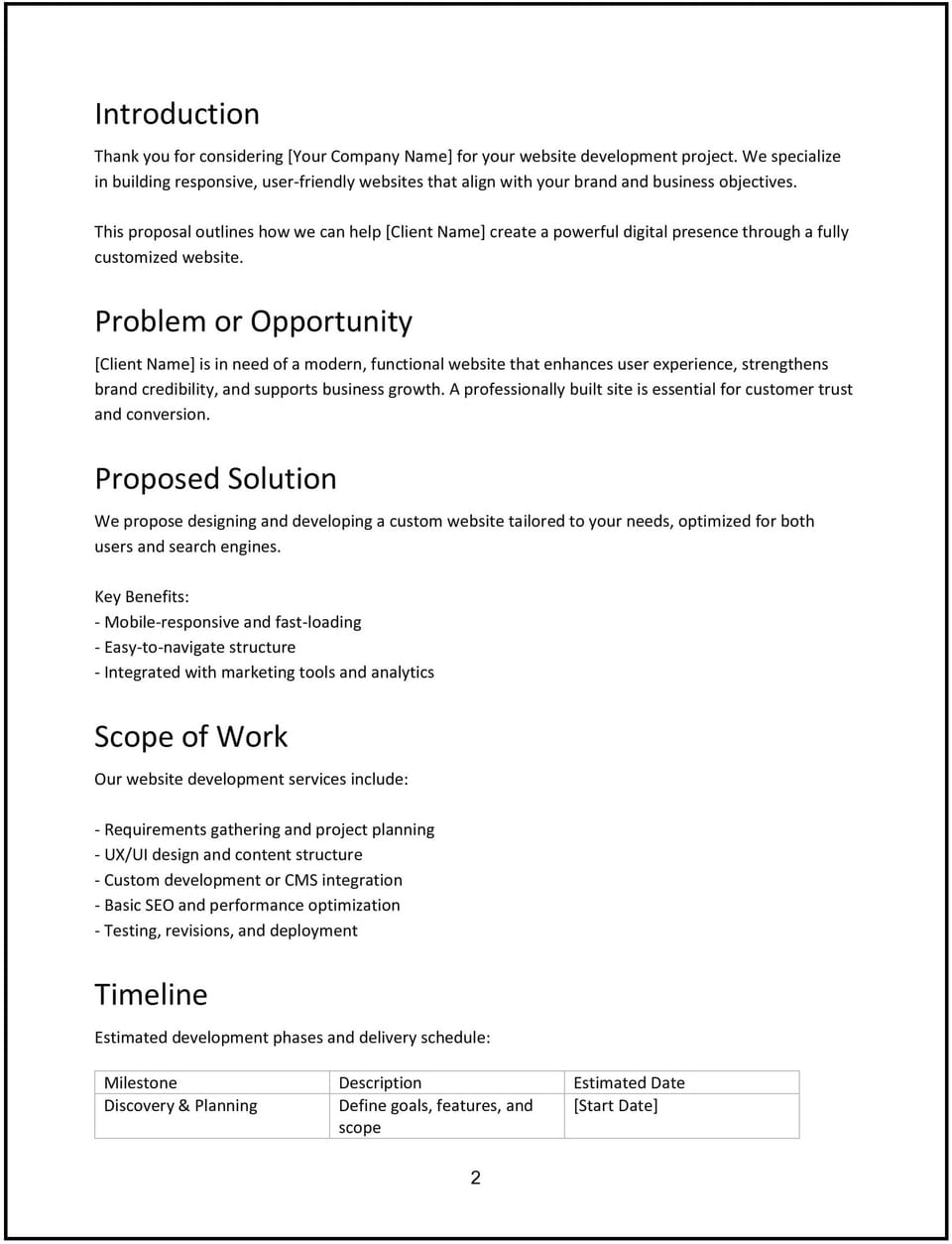Website development proposal: Free template

Customize this free website development proposal with Cobrief
Open this free website development proposal in Cobrief and start editing it instantly using AI. You can adjust the tone, structure, and content based on your design and technical approach, the client’s goals, and specific project requirements. You can also use AI to review your draft—spot gaps, tighten language, and improve clarity before sending.
Once you're done, send, download, or save the proposal in one click—no formatting or setup required.
This template is fully customizable and built for real-world use—ideal for pitching new websites, redesign projects, e-commerce platforms, or landing page campaigns. Whether you're a freelance web designer, digital agency, or web consultancy, this version gives you a structured head start and removes the guesswork.
What is a website development proposal?
A website development proposal outlines your strategy, deliverables, pricing, and timelines for building or redesigning a website. Typically sent after initial conversations or project discovery, it helps clients understand exactly what they'll receive, how the site will function, and what outcomes to expect.
This proposal clearly defines key elements such as web design, development stages, CMS choices, integrations, SEO considerations, and launch strategies—creating transparency from the start.
A strong website development proposal helps you:
- Clearly define website scope, features, and deliverables.
- Demonstrate your professional development process.
- Set realistic timelines and cost expectations.
- Establish trust and confidence with clients.
Use this template to deliver clear, persuasive proposals quickly.
Why use Cobrief to edit your proposal
Cobrief provides an intuitive way to quickly create, refine, and deliver polished website development proposals—all supported by built-in AI tools.
- Edit the proposal directly in your browser: No setup or formatting required—just start customizing immediately.
- Rewrite sections with AI: Instantly enhance clarity, simplify technical explanations, or adjust your proposal’s tone.
- Run a one-click AI review: Quickly identify unclear language, weak sections, or confusing details and improve them instantly.
- Apply AI suggestions instantly: Review and accept individual AI suggestions, or apply all improvements across the proposal in one click.
- Share or export instantly: Send the proposal via Cobrief or download a clean PDF or DOCX file instantly.
Cobrief helps you deliver professional, persuasive proposals with speed and confidence.
When to use this proposal
Use this website development proposal for situations such as:
- Proposing new website builds or redesigns.
- Pitching e-commerce sites with integrations (e.g., Shopify, WooCommerce).
- Responding to detailed website RFPs or creative briefs.
- Offering landing page development for specific marketing campaigns.
Use this template whenever clarity around web features, timelines, and outcomes is essential.
What to include in a website development proposal
This structure helps your client understand exactly what you’re delivering and how the project will unfold:
- Executive summary: Introduce the website project briefly, emphasizing its primary objectives—such as enhancing brand presence, driving conversions, or improving user experience.
- Scope of work: Clearly outline deliverables, including key pages, design elements, CMS options (e.g., WordPress, Webflow), integrations (analytics, CRM, payment gateways), and responsive/mobile functionality.
- Technical approach: Briefly specify your chosen technologies (e.g., React, WordPress, Shopify, Webflow) and explain their relevance and benefits.
- Project timeline: Detail project phases clearly—discovery, wireframing, design, development, testing, launch—with milestone dates or durations.
- Pricing: Provide clear pricing—fixed-price, phased milestones, hourly rates—and specify what's included at each stage. Clearly indicate any optional add-ons or ongoing maintenance packages.
- Terms and conditions: Explain payment terms, intellectual property transfer, revision rounds, hosting responsibilities, and cancellation policy in plain English.
- Next steps: End with a clear, actionable CTA—like “Reply to confirm” or “Schedule a call to get started.”
How to write an effective website development proposal
Your proposal should balance clear, technical accuracy with strategic persuasion:
- Focus on business results: Clearly link website features to specific business outcomes (e.g., increased conversions, better engagement, improved SEO).
- Be clear and specific: Avoid ambiguity in defining what’s included, such as the number of pages, features, or revisions.
- Keep language accessible: Translate technical jargon (e.g., CMS, SSL certificates, APIs) into straightforward terms that non-technical clients easily understand.
- Highlight your process: Explain clearly how you work, from initial consultation to final launch and training.
- Format for readability: Use headings, bullets, short paragraphs, and clear sections to enhance readability.
- End with confidence: Provide a straightforward, frictionless next step to move forward.
Frequently asked questions (FAQs)
Can I reuse this website proposal for different clients or projects?
Yes—simply adjust the scope, technical details, and project specifics for each new client.
Does this template cover both new websites and redesign projects?
Absolutely. You can easily tailor deliverables and descriptions accordingly.
Should I include website examples or case studies?
Yes, including relevant links or screenshots from past projects helps reinforce your credibility.
Is this proposal also a legally binding agreement?
No—this is just a proposal. You can attach a separate agreement or SOW if needed.
Can I export this proposal as a PDF or DOCX file?
Yes—after customizing, you can download it instantly as a professional PDF or DOCX document.
This article contains general legal information and does not contain legal advice. Cobrief is not a law firm or a substitute for an attorney or law firm. The law is complex and changes often. For legal advice, please ask a lawyer.